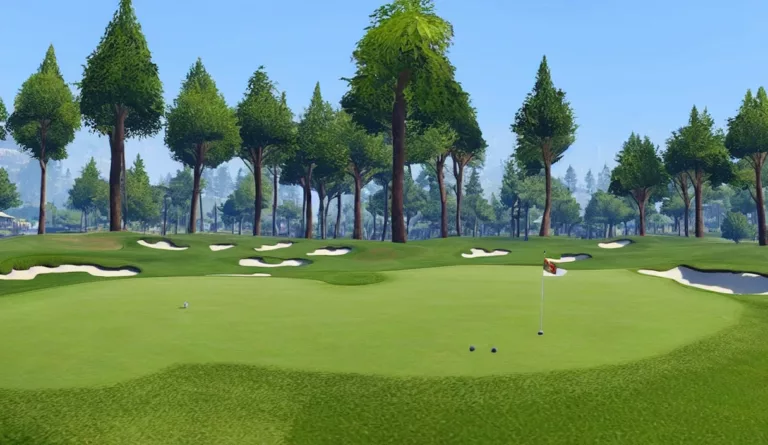Energize Your Golf Game in Your 60s with These Powerful Tips
Are you in your 60s and still want to hit the golf course? While age can be a factor in how well you play, it doesn’t have to stop you from enjoying the game. In this blog post, we will discuss some simple tips that will help you keep up with your golfing even as you get older. Keep reading to learn more!
more
Introduction to Golf in Your 60s
Playing golf in your 60s does not mean that you have to sacrifice your enjoyment of the game. In fact, by taking a few simple steps and following some basic advice, you can still enjoy playing golf at an advanced age. [“Before the game is started, it is important to understand that there are no magic years when you automatically become a better golfer.”, “Before you get started, it is important to understand that there are no magic years when you automatically become a better golfer.”, “It is important to understand, before starting, that there are no magic years when you automatically become a better golfer.”, “Before you start golfing, it is important to understand that there are no magic years when you automatically become a better golfer.”, “Before beginning it is important to understand that there are no magic years when you automatically become a better golfer.”] The best way to improve your game is through consistent practice, regardless of your age. Additionally, it’s helpful to be physically fit so that you can handle the demands of playing 18 holes for three hours.
Many people think that they need to stop playing golf after they reach their mid-60s because they no longer have the time or energy to do so. [“This mindset is however, obsolete and should not be pursued if you want to continue to enjoy the game at an advanced age.”, “Nonetheless, this mindset is outdated and should be avoided if you want to continue at a pillion age enjoying the game.”, “However, this mindset is outdated and should be avoided if you want to continue enjoying the game at an older age.”, “This mindset is therefore obsolete and should not be utilized if you want to continue playing at an advanced age.”, “However, this mindset is obsolete and should be avoided if you want to enjoy the game at an advanced age.”] In fact, many seniors who play regularly report increased overall well-being and improved social relationships as a result of their participation in golf clubs or tournaments.

Benefits of Playing Golf in Your 60s
Playing golf in your 60s can be a great way to keep your mind active and your body moving. Here are some of the benefits of playing golf:
- Playing golf can help keep your mind active. There is something about the challenge of hitting a ball into a hole that keeps your brain sharp.
- Playing golf can help you stay physically active. The repetitive motion of swinging a club can help you stay healthy and fit as you get older.
- Playing golf can be fun. If you’re someone who enjoys spending time outdoors, playing golf can be a great way to do that.
- Playing golf can be a great way to make new friends. Golf is a social sport, and playing with other people can be enjoyable and relaxing.
Get the Right Equipment for Your Age and Ability
When you’re ready to start playing golf at a younger age, consider choosing the right equipment. Unless you’re an experienced golfer, your initial purchase of clubs and balls will be expensive. It’s important to invest in good-quality items that will last you a while.
If you can’t swing a club very well, it might be best to stick with putting greens until you improve your game. Putting is generally less demanding than hitting shots from the teeing ground, so even if your irons don’t look as good as they once did, they may suffice for now. If you are interested in trying out golfing sometime soon, go ahead and purchase some clubs that will fit your skill level (assuming you have enough money saved up). If not, there are plenty of places to rent them or borrow them from friends or family members.

Start with the Basics: Grip, Posture, and Swing
Grip is one of the most important aspects of playing golf. You need to find a grip that is comfortable and allows you to hit the ball with accuracy. [“To start test a variety of grips until you find one that feels good.”, “To get started try a variety of grips until you find one that feels good.”, “To get started, try a variety of grips until you find one that feels good.”, “To start, try a variety of grips until you find one that feels good.”, “To get started, try a variety of grips until you find one that feels good.”] Another important aspect of playing golf is posture. Make sure to stand tall with your shoulders back and your chin up. This will help you swing at the correct height and achieve better balance on the ball.
Finally, focus on your swing by keeping your arms parallel to each other and keep your wrists bent. Try not to jerk your arms or twist your torso as you swing. This will give you more power and accuracy when hitting the ball
Practice Makes Perfect: Drills to Improve Your Game
Practice makes perfect, and there’s no better way to improve your game than by practicing drills. Here are a few drills to help you improve your golfing skills.
- Drive-away drill: This drill helps you improve your accuracy when hitting drives. Start by setting up a drive-away target on the green, and then hit a drive towards the target. Try to hit the ball as close to the center of the target as possible.
- Footwork drill: This drill helps you improve your footwork on the green. Start by setting up two lines on the green, and then walk between them. Try to keep your feet parallel to the ground at all times.
- Putting drill: This drill helps you improve your putting skills. Start by setting up a putting green, and then putt along the green until you reach the hole. Try to make sure that you make consistent putts of different distances.
- One-handed backhand drill: This drill helps you improve your one-handed backhand skills. Start by setting up a backhand target on the green, and then hit a backhand towards the target. Try to make sure that you keep your hand close to your body at all times.

Tips for Overcoming Common Challenges in Golfing at 60
Despite being in your 60s, you can still enjoy a round of golf. [“There are however some common challenges that older golfers face that need to be addressed before they can begin playing.”, “However, there are some common challenges that older golfers face that need to be addressed before they can begin to play.”, “However, there are some common challenges that older golfers face that need to be addressed before they can start playing.”, “There are however some common challenges that older golfers face and that must be addressed before they can start playing golf.”, “However, there are some common challenges facing older golfers that must be addressed before they can start playing.”] For example, many seniors experience difficulty swinging the club with the same power and accuracy as when they were younger. To overcome this challenge, it is important to practice regularly and make adjustments to your swing based on feedback from a professional golfer. Additionally, other senior players may find themselves struggling with their mental game. If this is the case for you, increasing your focus by doing yoga or meditation prior to each round can help you stay calm during pressure-packed moments on the green. Overall, these tips will help you improve both your technique and mental game while playing golf at 60 years old or older.
Strategies for Playing on Different Courses
Playing golf can be a lot of fun, and there are many different ways to improve your game. However, no matter how good you get, there are always going to be challenges that arise when playing on different courses. Here are some tips for overcoming common obstacles on different golf courses:
When playing testing rounds or practice rounds at a new course, it is important to pay attention to the layout and makesure you understand all the hazards and potential scoring opportunities. There is nothing more frustrating than hitting a great shot only to have it sailed way past the pin because you didn’t know about an ambush bunker near the tenth green!
It is also important to figure out which club suits your strengths and weaknesses on different courses. For example, if you tend to hit lots of long shots off the tee at your home course but struggle with irons in high rough at another course, try investing in some rain shoes or putters that feature loftier heads (for hitting high woods). Additionally, trying new tees can also help you play better by giving you a tighter clubface on tougher holes (assuming they’re within range!).
Experimenting with sequencing shots during a round can also give you an advantage over other players who stick rigidly to pre-determined hole plans. For instance, instead ofhitting your second ball from the green into one of two fairway bunkers immediately following your tee shot on eighteenth hole at your home course – take some time after striking the first ball for consideration before making your decision about where best to attack next! This aerial view might give you an idea about what lies ahead beyond those obstinate dune traps!.

How to Stay Motivated to Keep Playing Golf in Your 60s
It’s no secret that golf can be quite a daunting sport for those who are just starting out. However, with the right strategies and mindset, you can successfully play the game in your 60s. Here are some tips to help you stay motivated and enjoy playing golf:
First of all, it’s important to have a positive outlook on the game. Yes, it may take longer to hit a hole-in-one or score a perfect round than when you were younger, but that doesn’t mean you cannot still enjoy yourself while playing golf. Appreciate the simplicity of each shot and revel in any small victory along the way.
Secondly, make sure to practice regularly if you want to improve yourgame. A good rule of thumb is at least one round per week, but as long as your practice sessions are challenging enough (without being too demanding), shooting lower scores should not be impossible! If practicing on your own isn’t an option then search for amateur tournaments near you so that you can get more experience under your belt.
[“Lastly, don’t forget that golf is meant to be enjoyed with friends and family; don’t hesitate to invite them along for some friendly golfing fun!”, “Finally, never forget that golf is meant to be enjoyed with friends and family; don’t hesitate to invite them out for a round of friendly golfing fun!”, “Lastly, remember that Golf is meant to be enjoyed with friends and family ; don’t hesitate to invite them to some friendly rounds of golf fun!”, “In the end, forget that golf is meant to be enjoyed with friends and family \u2013 don’t hesitate to invite them along for some friendly games of golfing fun!”, “Never forget that golf is meant to be enjoyed with friends and family; don’t hesitate to invite them along for some friendly rounds of golfing fun!”] You will appreciate their company even more after scoring an impressive hole-in-one or completing an entire 18 holes without mishap!
Finding a Support Network of Other Senior Golfers
Maintaining Mobility and Flexibility
If you’re interested in playing golf in your 60s, there are some important things to keep in mind. First, make sure you have the ability to swing the club with good consistency. Second, find a group of friends or fellow seniors who can help support and encourage you when you start to struggle. Finally, stay mobile and flexible so that you can continue enjoying the game for years to come!
Staying Hydrated and Fueled
Finding a support network of other senior golfers can be a great way to stay motivated to keep playing golf in your 60s. Staying hydrated and fueled is essential for keeping your energy up, so make sure to drink plenty of water and eat nutritious snacks. Additionally, joining a golf club or league can provide you with social interaction and support while you continue to play.
Investing in the Right Equipment
For many seniors, the idea of playing golf again can seem daunting. However, with a little effort and support, you can get back on the green in your 60s. Finding a supportive group of other senior golfers is key to having a good experience. When looking for a group to join, make sure to consider their level of play and whether they have any specific equipment requirements that you may need.
Equipment is not the only thing that you will need to invest in if you want to keep playing golf during your retirement years. You will also need time and dedication to improve your skills. If you are serious about continuing your love affair with the green, make sure to take some time each week to practice. Begin by focusing on your basics, such as getting your stance and swing correct. Once you have those down, you can start to experiment with different shots. And, of course, don’t forget to have fun!
Developing a Practice Routine
Finding a Support Network of Other Senior Golfers
Most people find it difficult to maintain their regular exercise habits in their 60s, but playing golf is one activity that continues to be enjoyed for many seniors. A key element of sustaining the enjoyment and keeping your game improving into your 70s and 80s is finding golfing partners who share your interests and can provide support both on and off the course. There are several ways to find senior golfers in your area:
- Golf publications offer classified ads for members looking for partners.
- Local chapter organizations often have social events or club tournaments where seniors can join in competitive play.
- The internet provides opportunities to connect with other golfers across the country or world as well as provide information about senior golf clinics and events.
- Attendances at various local Senior Golf Association events are usually adequate to meet other seniors who may be looking for partners.
Building a Practice Routine
One of the best ways to improve your game is to establish specific practice habits that you can maintain over time. One important aspect of developing a routine is being able to commit yourself to regular play. It’s also beneficial to have structured practice sessions, with specific goals in mind, so that you can focus on improving your ball striking, sand saving techniques, or range-finding abilities. Finding an instructor or coach who can help develop a routine tailored specifically for your age and ability level is essential for optimizing your game performance.

Making the Most of Professional Lessons and Coaching
Invest in the Right Equipment
If you’re looking to improve your golf game, professional lessons and coaching can be a valuable investment. However, not all golfers are willing to pay for this type of help. There are plenty of free resources available to help you learn the game on your own.
Here are four tips for making the most of your practice time:
- Make use of a practice range. Many golfers find that practicing on a real course is the best way to improve their game. However, this isn’t always possible or affordable. A practice range can provide a similar experience without having to travel to a real course.
- Use video tutorials. There are many online video tutorials that can help you improve your golf game. Simply search for “golf tutorial” or “golf tips” on Google, YouTube, or other online resources.
- Join a golf club. Joining a golf club can provide you with a group of people to practice with and help you improve your game. However, make sure to find a club that is appropriate for your skill level.
- Take online golf lessons. Many golfers find that taking online golf lessons are the best way to improve their game. These lessons are typically offered by golf coaches or instructors who have years of experience teaching the game.
Stay Hydrated and Stretch
One of the most important things you can do to improve your golf game is to take professional lessons and receive coaching. However, it’s important to remember that there is no one-size-fits-all approach to golf improvement. What works for one golfer may not work for another.
That said, there are a few things that all golfers should do in order to improve their game. First, make sure you are practicing regularly. Second, make sure you are hydrated and stretch regularly. Finally, make sure you have a good practice routine in place.
Pace Yourself and Take Breaks
Learning to play golf at a slower pace can be a great way to make the game more enjoyable and help you avoid injury. While it may take some time to adjust, by following a practice routine and taking breaks, you can improve your skills and enjoy the game more.
Begin by setting realistic goals for your practice sessions. If you’re just starting out, aim to improve your basic swing mechanics and get comfortable with the course. As you become more skilled, you can focus on developing your game strategy and improving your accuracy.
To keep your practice sessions enjoyable, pace yourself and take regular breaks. Avoid practicing for hours on end without any breaks; instead, allow yourself 30 minutes of practice followed by a 10-minute break. This way, you’ll be able to complete sessions without feeling too tired or overwhelmed.
Finally, always consult a professional when starting out or if you experience any pain or discomfort while playing golf. They can help you develop a personalized practice routine and recommend the best strategy for your individual skills and capabilities.
Enjoy the Game and Have Fun!
If you’re looking to play golf at a high level in your 60s, you’ll need to put in the time and effort. However, with the right practice routine and some help from a professional, you can achieve your goals. [“Here are some tips to help you get started: 1.”, “Here are some tips to help you get started with: 1.”, “Here are some tips to help you get going: 1.”, “Here are some tips to help you get started.”, “Here are some tips to get you started:”] Develop a practice routine. [“Golf is a skill that can be improved through consistent practice.”, “Golf is a skill that can be improved with consistent practice.”, “Golf is a skill that can be improved with consistent practice.”, “Golf is a skill that can be improved with consistent practice.”, “Golf is a skill that can be improved with consistent practice.”] Make sure to set aside time each day to practice your swing. If you can’t find the time to practice regularly, consider hiring a professional instructor or taking lessons from someone who knows the game well.
- Be patient. It may take some time to improve your golf skills, but don’t give up on yourself. As long as you’re diligent in your practice, you’ll eventually reach your goals.
- Enjoy the game. [“Golf is a fun activity that can be enjoyed by everyone.”, “Playing golf is a fun activity that can be enjoyed by everyone.”, “Playing golf is a fun activity that can be enjoyed by everyone.”, “Playing golf is a fun activity that can be enjoyed by everyone.”, “The game of golf is a fun activity that can be enjoyed by everyone.”] Make sure to have fun while you’re practicing and playing, and don’t take the game too seriously.
- Stay healthy. Golf can be a physically demanding sport, so make sure to take care of your body by eating a balanced diet and exercising regularly. If you’re experiencing any health issues, talk to your doctor before starting a new exercise program.

Developing a Winning Mental Game
There are a few key things you can do to develop a winning mental game when playing golf. First and foremost, take the time to enjoy the game. No one ever became great by becoming obsessed with their performance or focusing on the negative thoughts that will inevitably enter their head. Second, have fun and forget about stats. Statistics tell you nothing about your play; they’re only indicative of what other people have done in the past. focus on how you’re playing today and how each shot is impacting your scorecard rather than worrying about what someone else has done. Finally, lose yourself in the moment – if you can truly let go and just focus on hitting the ball as best as possible, then odds are good that your play will improve dramatically over time.
Conclusion: Enjoying the Benefits of Golf in Your 60s
Playing golf in your 60s can be a rewarding experience, not only because you can enjoy the game more, but also because you can reduce your risk of developing health problems. By following these simple tips, you can start enjoying the benefits of golf at any age.
Golfing in your 60s can be a great way to stay active, have fun, and challenge yourself. With the right equipment, practice drills, and strategies for different courses, you can become a better golfer and enjoy the game for years to come. Don’t forget to find a support network of other senior golfers and take advantage of professional lessons and coaching to further improve your game. If you’re looking for more tips on how to play golf in your 60s, be sure to check out our other content.








